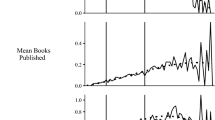Abstract
The purposes of this study are: (1) to differentiate scholarly effort from research activity, and (2) to test the notion that publications are a discrete measure of scholarly performance. Validity was established for 71 scholarly activities apart from publications; these were classified into two domains: the external-disciplinary colleague (EDC) and the institutional local-community (ILC). A mailed survey of a sample of PhD recipients in chemistry and psychology at 44 liberal arts colleges—Selectivity I yielded a 63% useable return on 186 respondents. High and low publishers (career and current) were compared on both EDC and ILC Domain performance. Findings were that high publishers (career and current) have higher levels of performance in both Domains than do low publishers (career and current).
Similar content being viewed by others
References
Babchuk, N., and Bates, A. P. Professor or producer: the two faces of academic man.Social Forces 1962,40 341–348.
Bayer, A. E., and Dutton, J. E. Career age and research-professional activities of academic scientists.Journal of Higher Education 1978,48 259–282.
Berelson, B.Graduate Education in the U.S. New York: McGraw-Hill, 1960.
Bess, J. L. Organizational implications of faculty roles—activity preferences. Paper presented at the Annual AERA Meeting, 1976, ERIC ED 134-089.
Biglan, A. The characteristics of subject matter in different academic areas.Journal of Applied Psychology 1973,57 195–203. (a)
Biglan, A. Relationships between subject matter characteristics and the structure and output of university departments.Journal of Applied Psychology 1973,57 204–213. (b)
Blackburn, R. T. The meaning of work in academia. InNew directions for institutional research: assessing faculty effort, No. 2, J. I. Doi (Ed.), San Francisco: Jossey-Bass, 1974.
Blau, P. M.The organization of academic work. New York: John Wiley & Sons, 1973.
Carnegie Commission on Higher Education.A classification of institutions of higher education. Berkeley, Calif.: Carnegie Commission, 1972.
Centra, J. A. Universities report their faculty evaluation practices.Findings 1978,4 1–4.
Cole, S., and Cole, J. R.Social stratification in science. Chicago: University of Chicago Press, 1973.
Crane, D. Scientists at major and minor universities: a study of productivity and recognition.American Sociological Review 1965,30 699–714.
Edwards, A. L.Techniques of attitude scale construction. New York: Appleton-Century-Crofts, 1957.
Eiduson, B. T. Productivity rate in research scientists.American Scientist 1966,65 57–63.
Etzioni, A., and Lehman, E. W. Some dangers in ‘valid’ social measurement.The Annals 1967,373 1–15.
Goode, W. J. and Hatt, P. K.Methods in social research. New York: McGraw-Hill, 1952.
Gouldner, A. W. Cosmopolitan and locals: toward an analysis of latent social roles.Administrative Science Quarterly 1957,2 281–306.
Hagstrom, W. O.The scientific community. New York: Basic Books, 1965.
Helmstadter, G. C.Principles of psychological measurement. New York: Appleton-Century-Crofts, 1964.
Jencks, C. and Riesman, D.The academic revolution. Garden City, N. Y.: Doubleday, 1968.
Ladd, E. C. Jr. The work experience of American college professors: some data and an argument, AAHE,Current issues in higher education, 1979.
Leslie, L. L. Are response rates essential to valid surveys.Social Science Research 1972,1 323–334.
Light, D. Introduction: the structure of the academic professions.Sociology of Education 1974,47 2–28.
Long, J. S. Productivity and academic position in the scientific career.American Sociological Review 1978,43 889–908.
Manis, J. G. Some academic influences upon publication productivity.Social Forces 1951,29 267–272.
Mayhew, L. B., and Ford P. J.Reform in graduate and professional education. San Francisco: Jossey-Bass, 1974.
McGee, R.Academic Janus. San Francisco: Jossey-Bass, 1971.
McGrath, E. J.The graduate school and the decline of liberal education. New York: Teachers College, Columbia University, 1959.
Merton, R. K.The sociology of science: theoretical and empirical investigations. Chicago: University of Chicago Press, 1973.
Miller, R. I.Developing programs for faculty evaluation. San Francisco: Jossey-Bass, 1974.
Neumann, Y. Standards of research publication: differences between the physical sciences and the social sciences.Research in Higher Education 1977,7 335–367.
Parsons, T., and Platt, G. M.The American academic profession: a pilot study. National Science Foundation, 1968 (mimeographed).
Parsons, T., and Platt, G. M.The American university. Cambridge, Mass.: Harvard University Press, 1973.
Pelz, D. C., and Andrews, F. H.Scientists in organizations: productive climates for research and development. New York: John Wiley & Sons, 1966.
Reskin, B. F. Academic sponsorship and careers.Sociology of Education 1979,52 129–146.
Rosen, B. C., and Bates, A. P. The structure of socialization in the graduate school.Sociological Inquiry 1967,37 71–84.
Shils, E. Intellectuals, tradition, and the tradition of intellectuals: some preliminary considerations.Daedalus, 101 21–34 (Spring, 1972).
Smart, J. C., and Elton, C. F. Goal orientations of academic departments: a test of Biglan's model.Journal of Applied Psychology 1975,60 580–588.
Storer, N. W.The social system of science. New York: Holt, Rinehart and Winston, 1966.
Toombs, W. A three dimensional view of faculty development.Journal of Higher Education 1975,46(6), 701–717.
Toombs, W. Awareness and use of academic research.Research in Higher Education 1977,7 743–765.
Wilson, L. The professor and his roles. InImproving college teaching, C. Lee (Ed.). Washington, D.C.: American Council on Education, 1967.
Author information
Authors and Affiliations
Rights and permissions
About this article
Cite this article
Braxton, J.M., Toombs, W. Faculty uses of doctoral training: Consideration of a technique for the differentiation of scholarly effort from research activity. Res High Educ 16, 265–282 (1982). https://doi.org/10.1007/BF00973587
Received:
Issue Date:
DOI: https://doi.org/10.1007/BF00973587



